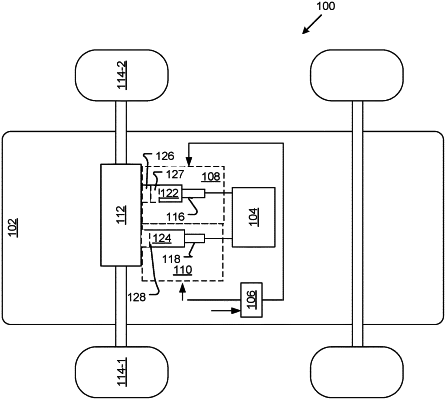| CPC H02P 5/485 (2016.02) [B60K 1/02 (2013.01); B60K 17/02 (2013.01); B60L 15/20 (2013.01); B60K 17/356 (2013.01); B60L 2210/40 (2013.01)] | 20 Claims |

|
1. A vehicle propulsion system comprising:
a first electric machine including a first set of machine windings that are configured to cause a rotor to rotate about an axis to selectively drive a transmission during a first vehicle operating state; and
a second electric machine including a second set of machine windings that are configured to cause a rotor to rotate about an axis selectively drive the transmission during at least one of the first vehicle operating state or a second vehicle operating state, the second vehicle operating state different from the first operating state,
wherein a total number of series turns per phase for the first set of machine windings is different from a total number of series turns per phase for the second set of machine windings.
|
|
11. A vehicle propulsion system comprising:
a first electric machine including a first set of machine windings that are configured to cause a rotor to rotate about an axis to selectively drive a first transmission during a first vehicle operating state;
a second electric machine including a second set of machine windings that are configured to cause a rotor to rotate about an axis selectively drive a second transmission during a second vehicle operating state, the second vehicle operating state different from the first operating state and the second transmission different from the first transmission; and
a controller operatively connected to the first electric machine and the second electric machine, wherein the controller is configured to transmit control signals to the first electric machine during the first vehicle operating state to cause the first electric machine to drive the transmission,
wherein a total number of series turns per phase for the first set of machine windings is different from a total number of series turns per phase for the second set of machine windings.
|
|
20. A method comprising:
receiving a torque request signal;
comparing a torque value corresponding to the torque request signal to a current operating state of a vehicle;
causing at least one of a first electric machine or a second electric machine to propel the vehicle based on the comparison, the first electric machine having a first set of machine windings and the second electric machine having a second set of machine windings, wherein a total number of series turns per phase for the first set of machine windings is different from a total number of series turns per phase for the second set of machine windings.
|